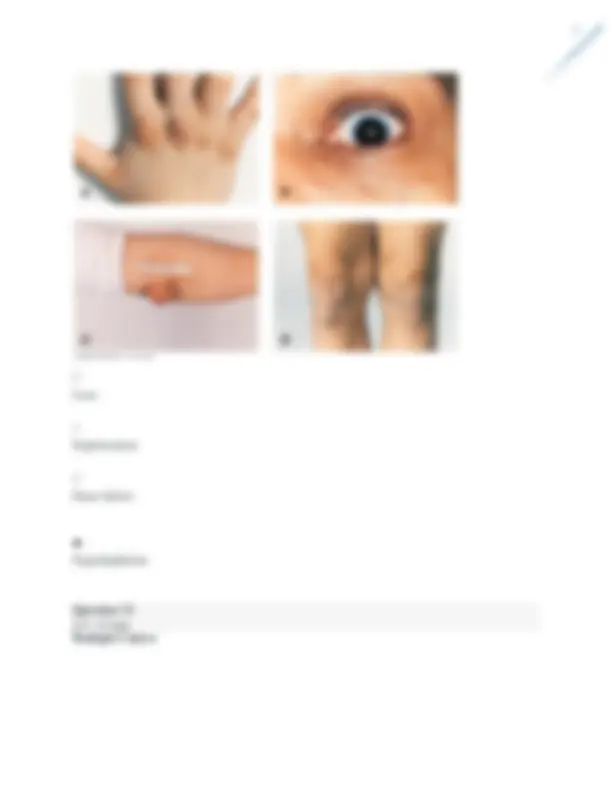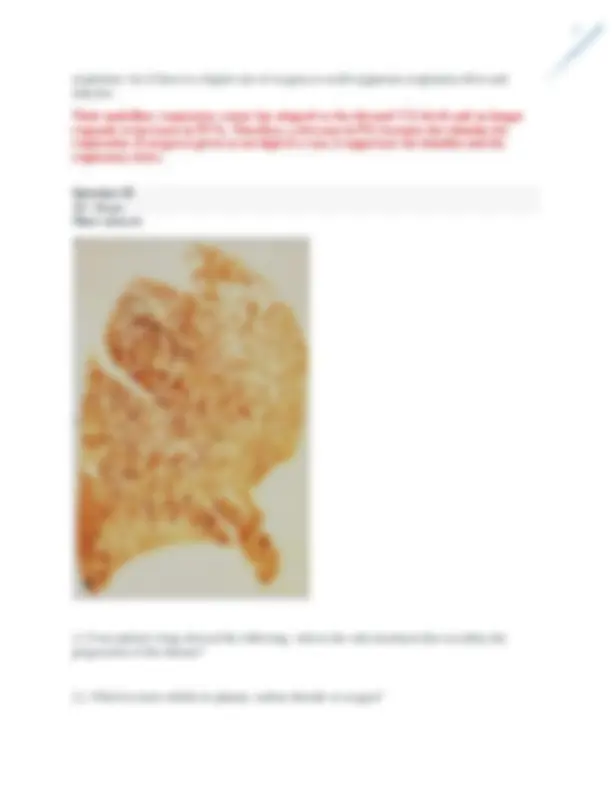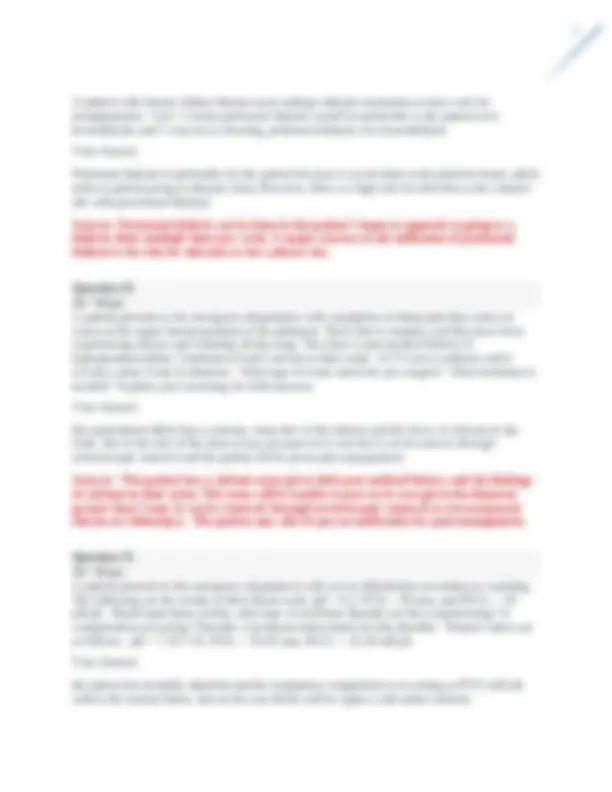






























































































Study with the several resources on Docsity

Earn points by helping other students or get them with a premium plan


Prepare for your exams
Study with the several resources on Docsity

Earn points to download
Earn points by helping other students or get them with a premium plan
Community
Ask the community for help and clear up your study doubts
Discover the best universities in your country according to Docsity users
Free resources
Download our free guides on studying techniques, anxiety management strategies, and thesis advice from Docsity tutors
Patho_Portage_Learning latest updated exam 2023#2024.docx
Typology: Exams
1 / 109

This page cannot be seen from the preview
Don't miss anything!





























































































Path 231 exams reviews Exam 1 True/False: Persistent metaplasia can lead to dysplasia. True False True/False: Barrett esophagus is an example of dysplasia. True Correct Answer False True/False: Cervical intraepithelial neoplasia is a type of dysplasia. Question 1 2.5 / 2.5 pts Question 2 0 / 2.5 pts Question 3 2.5 / 2.5 pts
True False True/False: Endometrial hyperplasia is a normal physiologic occurrence. True Correct Answer False Match the following:
Paracrine signaling depends on hormones Neurotransmitters act through synapses Enzyme linked receptors act through an on-off switch Autocrine signaling releases a chemical into the extracellular fluid that affects its own activity Multiple Choice Which of the following are false of the cell? Proteins carry out the functions of the cell membrane. Lysosomes are the digestive system of the cell. The rough ER is the site for lipid synthesis. Microfilaments are thin, threadlike cytoplasmic structures. Which is true of the cytoskeleton? Select all that apply. Question 8 2.5 / 2.5 pts Question 9 2.5 / 2.5 pts
It controls shape and movement Cilia and flagella are microtubule-filled cellular extensions It includes peroxisomes and proteasomes What factors are used by epidemiologic methods? Select all that apply. How disease is spread How to control disease How to prevent disease How to eliminate disease How to treat disease All of the above None of the above Question 10 1.88 / 2.5 pts
0 / 2.5 pts Multiple Choice Chemical agents (poison, alcohol) are examples of which of the following? Risk factors Clinical manifestations Pathogenesis Correct Answer Etiologic factors Define primary prevention and give an example: Your Answer: when the risk factors has to be remove to stop the disease from occurring example-eathing healthy / exercising to stay in shape or prevent heart disease.Giving vaccination to pervent disease in children The goal of primary prevention is to remove risk factors to prevent disease from occurring. Examples include taking folic acid while pregnant to prevent neural tube defects, vaccinating children to prevent communicable disease, eating healthy and exercising to prevent heart disease, and wearing seatbelts or helmets. Explain apoptosis and why it is necessary: Your Answer: apoptosis is the programmed of cell death.this process is necessary for cell dividing because it is removing unwanted cells to make way for new cell. Question 14 10 / 10 pts Question 15 10 / 10 pts
Apoptosis is programmed cell death. This process eliminates cells that are worn out, have been produced in excess, have developed improperly, or have genetic damage. Apoptosis is also responsible for several normal physiologic processes, like replacing cell in the intestinal villi and removing aging red blood cells. Explain what necrosis is and give an example and description of one type of necrosis. Your Answer: necrosis is when cell dies in an organ/tissues that is still alive .this process can interferes with the tissue regeneration and how cell can be replace. one type of necrosis is gengrenouse necrosis which can bowel or the lower extremities that may causes changes in tussue and it functions Necrosis refers to cell death in an organ or tissues that is still part of a living person. It often interferes with cell replacement and tissue regeneration. Coagulative necrosis results most often from a sudden cutoff of blood supply to an organ (ischemia), particularly the heart and kidney. Liquefactive necrosis occurs when some of the cells die but their catalytic enzymes are not destroyed. It is commonly seen with brain infarcts or abscesses. Caseous necrosis occurs as part of granulomatous inflammation and is most often associated with tuberculosis. Gangrenous necrosis most often affects the lower extremities or bowel and is secondary to vascular occlusion. The term gangrene is applied when a considerable mass of tissue undergoes necrosis. In dry gangrene the affected tissue becomes dry and shrinks, the skin wrinkles, and its color changes to dark brown or black. The spread of dry gangrene is slow. It results from a cut off in arterial blood supply and is a form of coagulation necrosis. In wet gangrene, the affected area is cold, swollen, and pulseless. The skin is moist, black, and under tension. Blebs form on the surface, liquefaction occurs, and a foul odor is caused by bacterial action. The spread of tissue damage is rapid. Match the type of cell injury to the cause. Some answers may be used more than once. (1 point each)
Radiation treatment Lead toxicity Bacteria List the 4 types of tissue found in the body. Pick 2 and give a description and example of each. Your Answer: nervours tissue-can be find throughout the body and it's used for communication. muscle tissue connective tissue epithelial-(covers the outer surface of the body and lines the inner surfaces. Epithelial tissue covers the body’s outer surface, lines the inner surfaces, and forms glandular tissue. Epithelial tissue has three distinct surfaces and the basal surface is attached to an underlying basement membrane. It is avascular, meaning without blood vessels. It receives oxygen and nutrients from the capillaries of the connective tissue on which it rests. Connective or supportive tissue is the most abundant tissue in the body. It connects and binds or supports the various tissues. Its cells produce the extracellular matrix that support and hold tissues together. Connective tissue is divided into two types: connective tissue proper and specialized connective tissue (cartilage, bone, and blood cells). The four types of connective tissue proper are loose (areolar), adipose, reticular, and dense connective tissue. The function of muscle tissue is to move the skeletal structures, pump blood through the heart, and contract the blood vessels and visceral organs. Muscle tissue can accomplish this by contraction. The two types of fibers that contract are called thin and thick filaments. Thin filaments are called actin, and the thick filaments are myosin. The three types of muscles tissue are skeletal, cardiac, and smooth. Nervous tissue is distributed throughout the body for communication. It provides the means for controlling body function and for sensing and moving about the environment. b. Radiation injury c. Chemical injury d. Biologic agents Question 18 5 / 10 pts
The two types of cells are neuron and glial cells. Neurons function is communication. Glial (meaning glue) cells support the neurons. What term means “cell eating” and engulfs and then kills microorganisms or other particulate matter? Your Answer: cell eating is refered to phagocytosis Phagocytosis What term means “cell drinking,” and engulfs small solid or fluid particles, as seen with proteins and electrolytes? Your Answer: cell drinking is refrered to pinocytosis Pinocytosis Give one function of a membrane potential: Your Answer: membrane potential can causes music contractions Generate nerve impulse, muscle contractions, or cause hormone secretion What is the term that best describes the following process? A transport protein aiding a lipid insoluble or large molecule across the cell membrane that would otherwise not be able to pass through on its own. Your Answer: Facilitated diffusion facilitated diffusion Exam 2 Question 19 2.5 / 2.5 pts Question 20 2.5 / 2.5 pts Question 21 2.5 / 2.5 pts Question 22 2.5 / 2.5 pts
Cell proliferation is the process in which proliferating cells become more specialized cell types. True False False, cell differentiation True/False: Cell differentiation is the process in which proliferating cells become more specialized cell types. Correct Answer True False This type of cell remains incompletely differentiated throughout life: Your Answer: stem cell stem cell These are cells of the same lineage that have not yet differentiated to the extent that they have lost their ability to divide: Your Answer: they are progenitor progenitor or parent cells Question 7 0 / 2.5 pts Question 8 2.5 / 2.5 pts Question 9 2.5 / 2.5 pts
Leiomyoma is a benign tumor. (Leiomyosarcoma is malignant) Student can add any of the following: Benign tumors are well-differentiated cells, resemble the cells of tissues of origin, and have a slow, progressive rate of growth. They grow by expansion and remain localized to their site of origin, not capable of metastasizing. They develop a rim of connective tissue around the tumor called a fibrous capsule, which aids in surgical removal. Benign tumors are less of a threat unless they interfere with vital functions Malignant neoplasms invade and destroy tissue. They grow rapidly, spread to other parts of the body, and lack well-defined margins. They can compress blood vessels and outgrow their blood supply, causing ischemia and tissue injury. Surgery can be more difficult if it has spread. A 62-year-old man with a 30-pack year smoking history is diagnosed with small cell lung cancer with metastasis to the bone. (1) Explain the process of how cancer spreads metastatically. (2) What symptoms might he have presented with? (3) Which screening test would he have benefited from? Your Answer:
Well-differentiated cells Fibrous capsule What are molecular and cellular mechanisms in genes that increase susceptibility to cancer? Select all that apply. Correct Answer Lack of cellular senescence Angiogenesis Ability to undergo apoptosis Mutations in growth factor signaling pathways Intact DNA repair genes List 4 of the 7 risk factors linked to cancer as stated in the module. Your Answer: 1)obesity Question 16 0 / 3 pts Question 17 4 / 4 pts
Cancer cells can show cytoskeletal changes or abnormalities. This includes abnormal intermediate filament types or changes in actin filaments and microtubules that help with invasion and metastasis. Which of the following is not a risk factor for developing cancer? Sunscreen Obesity HPV High red meat intake All of the following viral agents are correctly paired with the associated lesion except: Human papillomavirus (HPV): genital warts Epstein-Barr virus: carcinoma of the cervix Epstein Barr is linked to Burkitt lymphoma and nasopharyngeal cancer. Cervical carcinoma is linked to HPV. Hepatitis B virus: hepatocellular carcinoma Human herpes virus-8: Kaposi sarcoma Question 19 3.5 / 3.5 pts Question 20 3.5 / 3.5 pts
List one example of screening for each method: observation, palpation, and lab test/procedure: Your Answer: observation-external genitalia palpation-lymph nodes lab test/procedure-pap smear Observation: skin, mouth, external genitalia Palpation: breast, thyroid, rectum and anus, prostate, lymph nodes Laboratory tests and procedures: Pap smear, colonoscopy, mammography Exam 3 Short answer Explain the challenges of diagnosing autoimmune disorders. Your Answer: since there are too many autoimmune disorder,diagnosing is made by serological finding,history or physical testing.blood testing could have been a good way to test but since some blood are more generic can be elevated to show other diseases therefore it best go by finding that are listed. There are over 80 identified, many with overlapping presentations. Many manifestations are nonspecific and are seen in other non-autoimmune diseases. Blood testing isn’t perfect either, as some tests are more generic and can be elevated in the presence of other diseases. Multiple choice: Which cell is the first responder to phagocytose a foreign invader? Monocyte Question 1 5 / 5 pts Question 2 2.5 / 2.5 pts Question 21 3 / 3 pts